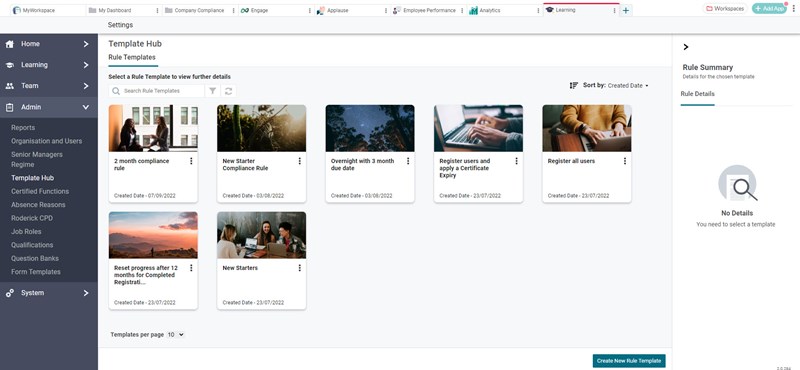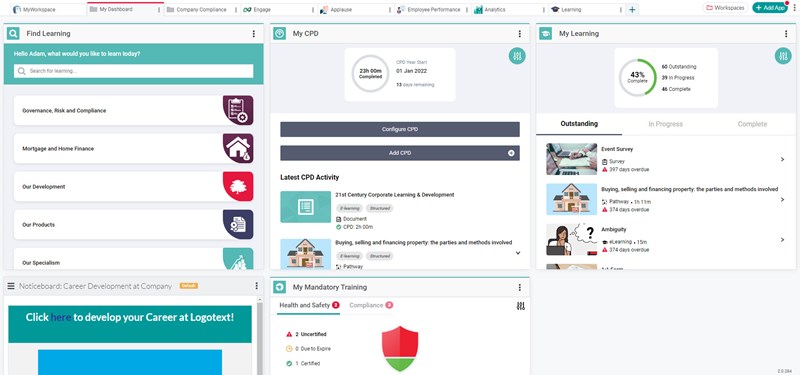-
- Learning Management System
- Learning Management System
- eLearning Courses
- Gamified Learning Solutions
- Content creation software
-
- eLearning Courses
- eLearning Courses
- Compliance eLearning
- Compliance eLearning for Financial Services
- Cyber Security Awareness eLearning
- Health & Safety eLearning
- Mental Health & Wellbeing eLearning
- Workplace Skills and Personal Development eLearning
- Online teaching resources for schools
- Self Directed Learning
-
- Career Development
- Career development for staff
- Developing student employability
- Employability Software

How to use an LMS for compliance training
In a world of frequently updated regulations and new challenges, it’s no surprise that compliance is moving quickly.
Organisations need to be able to keep up and adapt with the landscape as it develops, without their compliance demands getting left behind.
Implementing a compliance training management system is the ideal way to create a streamlined process and keep everything in one place. This will ensure that you are in a position to protect your organisation, employees and customers, whilst abiding by the ever-changing regulations.
 7 minutes
7 minutes
Written by Richard Whittington
In this article we will look at the following topics:
- How an LMS can be used for compliance training management
- How to use learning management software for successful compliance training
- How an LMS improves the employee onboarding experience
- Navigating ongoing and annual compliance training with an LMS
- How to manage CPD records using an LMS for compliance training
- Keeping up to date with compliance data management
- How can an LMS assist in creating a culture of compliance?
- How to choose the right LMS for Compliance Training Management
How an LMS can be used for compliance training management
How to use learning management software for successful compliance training
Learning management software is a valuable tool used by many compliance managers and L&D teams. Due to the frequency and variety of assessments that need to be kept track of, often on an annual basis, there is no room for error. Taking on this responsibility as a manual task can lead to errors occurring without it being noticed. Using a compliance training management platform where alerts, messages and certification is provided will reduce the problems that arise.
For compliance managers, the buck usually stops with them meaning it is their responsibility to implement, track and report back on compliance training. Key areas where an LMS can add great value includes:
- Time management and keeping on top of necessary training
- Getting the right data and information to the right people at the right time
- Keeping up with legislation and regulatory changes
- Reducing stress by automating certain aspects
If these aspects are not handled correctly, it can be detrimental to your company as a whole. This could involve fines, the loss of licenses and will inevitably impact the reputation of your company, something which can be extremely difficult to undo.

We offer 40+ CPD accredited compliance eLearning courses, written by experts and regularly updated.
How a compliance LMS improves the employee onboarding experience
It is a tricky task to keep on top of onboarding when there is an influx of new starters. Pair this with employees moving roles internally and it can feel like a never ending stream of onboarding tasks and activities. For compliance or L&D teams, this often means getting employees up to speed with the information they need to be able to do their job effectively.
Automating the process will reduce a lot of admin time and get people ready in a much more efficient way, meaning that they will be in a position to show their strengths and add value to the wider business more quickly.
It may be the case that compliance training and the passing of assessments are needed in order for a manager to be able to successfully sign off a probationary period, which makes delays far more problematic. This can even be detrimental to the employees onboarding process and their feeling of belonging within the company as a whole.
A learning pathway can be set up on an LMS for all new starts which will allow them to:
- View all of the information they need at the relevant time
Test their competence
Review and sign internal policies
Get alert emails letting them know when further compliance training is due
A compliance LMS will automate many tasks and in turn, reduce the worry that can come with compliance training expectations. It means that onboarding training cycles can tick along automatically, removes the burden of manually assigning training to each individual and ensures policies are read and signed on time.
A compliance training LMS will also keep track of the follow up tasks and admin that usually goes along with this, allowing compliance managers to focus on other aspects of their role.
Navigating ongoing and annual compliance training with an LMS
It is important for compliance training to be completed on an annual basis which can bring its own set of challenges. Employees may remember small sections of information from previous training which can then make the assessments feel like a memory game and not a learning and training exercise.
This also wastes time, and therefore resource in going over information they already know. Instead, you want to be able to create engaging content that will challenge people, provide new information, and offer something they can get stuck into.
Tools like diagnostic assessments will check in with employees and find out where their strengths lie and what they do need a refresher on. This will create a unique and targeted learning experience based on gaps in their knowledge, ensuring that they don’t have to sit through just another compliance course.
It’s also important to look at compliance training from the perspective of a compliance manager, who will need to assign the training to the correct people exactly when they need it.
Automating this process will take pressure off the team member and allow them to focus on other areas, such as keeping up to date with the latest legislations.
How to manage CPD records using an LMS for compliance training

Keeping up to date with compliance data management
Management information is essential for compliance, especially when this relates to managing compliance training at scale. It can help to demonstrate the level of compliance and competence within your workforce, enable you to analyse trends and identifies any gaps you may need to close.
Generating accurate and reliable reporting in real time is an absolute must for both training purposes and if a compliance audit occurs – the information on record will come under scrutiny so needs to be correct and up to date.
A platform or dashboard in which employees can view their training progress will encourage them to continue with their learning. This tool can also be helpful for management, as they can use the information gathered to shape new learning for specific members of staff, ensuring that it is tailored and targeted.
How can an LMS assist in creating a culture of compliance?
Creating a culture of compliance within an organisation starts from the very top and filters down, but employees must be willing to play their part in order for it to be rolled out successfully.
It is important for your company and employees not to view any training they complete as only something mandatory that is ticked off then ignored. Instead, training should be engaging, easy to use and available when needed.
A modern way of learning reduces the need for sitting in classrooms and poring over textbooks, replacing it with online learning that is available as and when needed for each individual.
A compliance training LMS will assist with the following aspects:
- Bringing all the right tools and information together in one platform
Embedding a culture of compliance training across the business
Offering your employees an engaging way of taking on compliance training
Want to find out how our compliance LMS can help your business?
How to choose the right LMS for Compliance Training Management
Taking into consideration all the points raised in this article, you should have a good idea of what to expect from your learning provider. Your compliance training LMS must be in a position to offer training at scale, automated reminders for upcoming compliance training, and diagnostic tools to reveal knowledge gaps and ensure the correct training is issued.
It is also important that the system is easy to use and encourages a culture of continued compliance learning and training.
At Access, our compliance training LMS platform and learning content library put you in charge of your learning.





